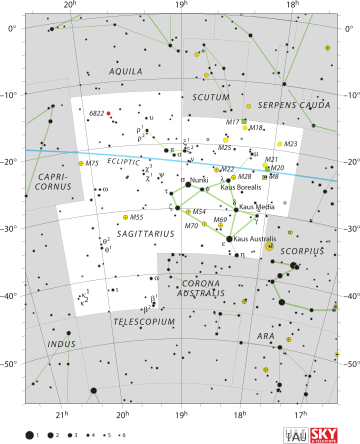Nu1 Sagittarii (ν1 Sagittarii, abbreviated Nu1 Sgr, ν1 Sgr) is a triple star system[7] about 1,100 light-years from Earth. Its three components are designated Nu1 Sagittarii A (officially named Ainalrami /ɛnəlˈreɪmi/, the traditional name for the system),[8] B and C.[9] A and B themselves form a spectroscopic binary.[7] The system is 0.11 degree north of the ecliptic.
| Observation data Epoch J2000.0 Equinox J2000.0 (ICRS) | |
|---|---|
| Constellation | Sagittarius |
| Right ascension | 18h 54m 10.17695s[1] |
| Declination | −22° 44′ 41.4247″[1] |
| Apparent magnitude (V) | +4.86[2] |
| Characteristics | |
| Spectral type | G2/K1 Ib/II + B9.2p[3] |
| U−B color index | +1.34[2] |
| B−V color index | +1.43[2] |
| Astrometry | |
| Radial velocity (Rv) | −11.57[4] km/s |
| Proper motion (μ) | RA: +4.291[4] mas/yr Dec.: −7.786[4] mas/yr |
| Parallax (π) | 2.3170 ± 0.2139 mas[4] |
| Distance | 1,400 ± 100 ly (430 ± 40 pc) |
| Absolute magnitude (MV) | −3.91[5] |
| Details | |
| Radius | 101[4] R☉ |
| Luminosity | 3,464[4] L☉ |
| Temperature | 4,401[4] K |
| Other designations | |
| Database references | |
| SIMBAD | data |
Nomenclature
ν1 Sagittarii (Latinised to Nu1 Sagittarii) is the system's Bayer designation.
Nu1 and Nu2 Sagittarii (together designated Nu Sagittarii) bore the traditional name Ain al Rami, which is from the Arabic عين الرامي ʽain al-rāmī meaning 'eye of the archer'.[10] In 2016, the IAU organized a Working Group on Star Names (WGSN)[11] to catalog and standardize proper names for stars. The WGSN decided to attribute proper names to individual stars rather than entire multiple systems.[12] It approved the name Ainalrami for the component Nu1 Sagittarii A on 5 September 2017 and it is now so included in the List of IAU-approved Star Names.[8]
Nu1 and Nu2 Sagittarii, together with Tau Sagittarii, Psi Sagittarii, Omega Sagittarii, 60 Sagittarii and Zeta Sagittarii were Al Udḥiyy, the Ostrich's Nest.[10]
Properties
Nu1 Sagittarii A is a spectral type K1 bright giant which has an apparent magnitude of +4.86. It is a microvariable with a frequency of 0.43398 cycles per day and an amplitude of 0.0078 magnitude.[13] In 1982 it was found to have a hotter companion, Nu1 Sagittarii B, a rapidly rotating B9 type star.[14] The pair orbit with a period of around 370 days.[7] A magnitude +11.2 companion, component C,[9] is orbiting further out at an angular separation of 2.5 arcseconds from the primary.[7]
References
Wikiwand in your browser!
Seamless Wikipedia browsing. On steroids.
Every time you click a link to Wikipedia, Wiktionary or Wikiquote in your browser's search results, it will show the modern Wikiwand interface.
Wikiwand extension is a five stars, simple, with minimum permission required to keep your browsing private, safe and transparent.

